Chapter 3 -- Major Features Of the 1995 Budget Plan (Part II)
Health & Social Services
In this section, we describe the major features of the health and welfare funding in the budget package. The 1995-96 budget for health and welfare programs includes $13.9 billion from the General Fund. This represents a slight decrease (less than 1 percent) from the prior year.
Anticipated health and welfare caseloads will increase at rates ranging from 2 percent to 5 percent. However, the cost of caseload increases is partially offset by anticipated receipt of additional federal funds and a variety of savings actions adopted as part of the 1995-96 budget plan.
Figure 9 shows the major General Fund changes in these programs that were adopted in the 1995-96 budget. As the figure shows, the largest savings result from grant reductions in the Supplemental Security Income/State Supplementary Program (SSI/SSP) ($246 million) and the Aid to Families with Dependent Children (AFDC) Program ($141 million)
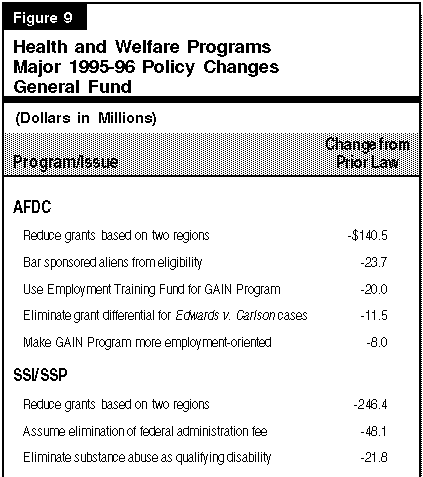
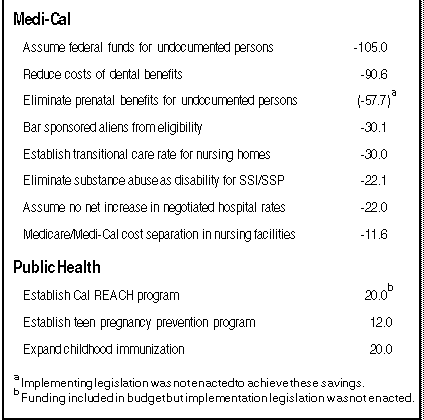
AFDC Program
The AFDC Family Group (FG) and Unemployed Parent (U) Programs provide cash grants to low-income families with children. The AFDC Foster Care Program provides grants to pay for the care of children placed in foster family homes or group homes. The budget plan provides $3.1 billion from the General Fund for the AFDC Program in 1995-96. This represents a decrease of 4.8 percent from estimated 1994-95 expenditures.
Regional Grant Reductions. The budget reduces AFDC grants by 4.9 percent, with an additional 4.9 percent reduction for recipients residing in low-cost counties (as measured by rental housing costs), effective October 1995, for a General Fund savings of $141 million in 1995-96. This will reduce the monthly grant for a three-person family from $594 to $565 in high-cost counties and to $538 in low-cost counties. The high-cost counties are Alameda, Contra Costa, Los Angeles, Marin, Monterey, Napa, Orange, San Diego, San Francisco, San Luis Obispo, San Mateo, Santa Barbara, Santa Clara, Santa Cruz, Solano, Sonoma, and Ventura. The reduction applied to all recipients will terminate June 30, 1996, and the additional reduction to recipients living in low-cost counties will be ongoing. (See Figure 10.)
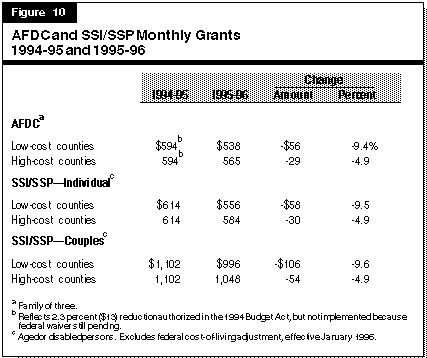
Greater Avenues for Independence (GAIN) Program. The budget includes a transfer of $20 million from the Employment Training Fund to support the GAIN Program, for a corresponding General Fund savings in 1995-96. The budget also assumes AFDC grant savings of $8 million (General Fund) from enactment of GAIN Program changes designed to make the program more employment-oriented (AB 1371, Weggeland).
Edwards v. Carlson. Beginning in 1992-93, the Edwards v. Carlson decision required the state to provide higher AFDC grants in certain cases (a caretaker relative and nonsibling children). In 1995, the U.S. Supreme Court reversed this lower court decision. The budget reflects the Governor's proposal to eliminate the grant differential, for a General Fund savings of $11.5 million in 1995-96.
Teen Pregnancy Disincentive Program. The Legislature adopted the Governor's proposal to require AFDC parents under age 18 to live in the home of their parent or guardian except under certain circumstances, such as when the health or safety of the teen or her child would be jeopardized. The budget assumes that grant savings would be offset by child welfare services costs, for no net fiscal effect in 1995-96.
SSI/SSP
The SSI/SSP is a state- and federally-funded program that provides grants to low-income aged, blind, and disabled persons. The Budget Act appropriates $2.1 billion from the General Fund for the program in 1995-96, which is a decrease of less than 1 percent from estimated 1994-95 expenditures.
Regional Grant Reductions. The budget reduces SSI/SSP grants by 4.9 percent, with an additional 4.9 percent reduction for recipients residing in low-cost counties, effective December 1995, for a net General Fund savings of $246 million in 1995-96. This will reduce the monthly grants for aged and disabled individuals (the largest category of recipients) from $614 to $584 in high-cost counties and to $556 in low-cost counties. The reduction applied to all recipients will terminate June 30, 1996, and the additional reduction to recipients living in low-cost counties will be ongoing. (See Figure 10.)
Elimination of Federal Administrative Fee. The budget assumes enactment of federal legislation, effective October 1995, to eliminate the federal fee for administering state-funded supplemental benefits, for a General Fund savings of $48 million in 1995-96.
Medi-Cal Program
The California Medical Assistance (Medi-Cal) Program provides health care services to public assistance recipients and other qualified persons who cannot afford to pay for these services. The federal government provides $8.5 billion for the program, and the budget appropriates $6.1 billion in matching funds from the state General Fund in 1995-96. This represents an increase of 1 percent over estimated General Fund expenditures in 1994-95.
Services to Undocumented Persons. The budget assumes receipt of $105 million in federal funds to partially offset state costs for emergency health services provided to undocumented immigrants. The budget also assumes elimination of the state-only program providing prenatal benefits to undocumented women, for a General Fund savings of $58 million in the budget year. However, implementing legislation was not enacted to achieve the savings in prenatal benefits to undocumented women.
Optional Benefits. While the Legislature rejected the Governor's proposal to eliminate optional benefits, it did reduce the costs of the dental program. Specifically, the budget (1) defers cost-of-living adjustments for dental rates in 1995-96, for a General Fund savings of $39.8 million, and (2) reduces rates an average of 14 percent and eliminates two procedures for an additional savings of $50.8 million.
Sponsored Aliens. The budget assumes enactment of federal legislation to prohibit immigrants who are sponsored by a U.S. citizen from receiving Medi-Cal or Aid to Families with Dependent Children (AFDC) benefits for five years. This would result in General Fund savings of $30 million in the Medi-Cal Program and $24 million in the AFDC Program in 1995-96.
Transitional Care Rate. The budget establishes a higher reimbursement rate for nursing facilities (effective January 1996) as an incentive to accept certain patients who would otherwise remain in acute care hospitals at a higher cost. This results in an estimated General Fund savings of $30 million in 1995-96.
Qualifying Disability for SSI/SSP Benefits. The budget assumes enactment of federal legislation to eliminate alcohol or drug abuse as a qualifying disability for the Supplemental Security Income/State Supplementary Program (SSI/SSP) program. This would result in General Fund savings of $22 million in SSI/SSP grants and $22 million in Medi-Cal benefits in 1995-96.
Hospital Payments. The budget assumes that the California Medical Assistance Commission will negotiate no net increase in hospital inpatient reimbursement rates in 1995-96, for an estimated General Fund savings of $22 million from base budget projections.
Medi-Cal/Medicare Cost Separation. Medi-Cal long term care rates are currently determined using a methodology which combines the costs of services provided to both Medi-Cal and Medicare patients. The budget establishes a new rate-setting methodology which separates out the Medicare costs. This results in an estimated General Fund savings of $11.6 million in 1995-96.
Public Health
The Department of Health Services administers a broad range of public health programs, including (1) programs that complement and support the activities of local health agencies controlling environmental hazards, preventing and controlling disease, and providing health services to populations who have special needs and (2) state-operated programs such as those which license health facilities and certain types of technical personnel.
Reaching Early Access for Children's Health (REACH) Program. The budget includes $20 million from the General Fund (and $20 million in assumed federal funds) to expand outpatient health care services effective April 1996 to children in low-income households, which currently pay a share of cost for such services or do not qualify for services The program would cover children, aged 0-5, who are legal residents and whose family income levels fall between 133 percent and 200 percent of the federal poverty level. However, implementing legislation for this program was not enacted.
Teen Pregnancy Prevention Program. The Budget Act appropriates $12 million from the General Fund for a comprehensive teen pregnancy prevention program. Funding will go towards a media campaign ($5.8 million), local intervention programs ($2.9 million), increased enforcement of statutory rape laws ($2.4 million), and an AFDC informational campaign ($1 million).
Distribution of Proposition 99 Revenues is Changed. The Legislature adopted legislation (Ch 194/95 [SB 493, Maddy]) to decrease the percentage of Proposition 99 revenues (the Tobacco and Health Protection Act of 1988) allocated to the Health Education and Research accounts, and increase the revenues to the Physician Services and Unallocated accounts, for 1995-96. This was in response to an earlier court ruling that statutory appropriations of Proposition 99 funds from the Health Education and Research accounts for certain health programs violated the provisions of the proposition. Senate Bill 493 was designed to permit the expenditure of $63.7 million for various health and related programs. However, implementation of the bill has been enjoined by the Superior Court.
Child Immunization Program. The budget provides $20 million from the General Fund (equivalent to the savings from free federal vaccines) for a program to raise immunization rates among children. Funds will support the provider rate increases ($9 million), grants to improve outreach ($4 million), development of a local immunization tracking system ($3.3 million), grants to expand services ($3.5 million), and state administration ($200,000).
Substance Abuse Treatment
The Department of Alcohol and Drug Programs (DADP) performs Medi-Cal related functions under an agreement with the Department of Health Services.
Drug/Medi-Cal Program. The Legislature rejected the Governor's proposal to eliminate the Drug/Medi-Cal program (D/MC), but adopted certain cost-containment measures, for an estimated General Fund savings of approximately $50 million in 1995-96 (to be redirected to drug treatment services). Specifically, the budget legislation:
- Reduces the maximum rates providers can bill for substance abuse treatment services.
- Establishes a maximum reimbursement rate for outpatient group counseling in a drug-free setting.
- Limits the provision of day care habilitative and perinatal services to pregnant and postpartum women.
- Limits the provision of outpatient "drug-free" services to pregnant and postpartum women, effective July 1, 1996, if the May 1996 projected cost for the D/MC program exceeds $60 million (General Fund) for 1995-96.
Long-Term Care for Developmentally Disabled Clients
Individuals with developmental disabilities reside in state-operated developmental centers (DCs) or receive services in the community through regional centers.
Closure of Stockton DC. Due to the rapidly declining population in the DCs, the budget reflects the closure of the Stockton DC, for an estimated savings of $2.5 million in all funds (no General Fund) in 1995-96. The Department of Developmental Services estimates the ongoing annual savings will be about $13.2 million ($7.2 million General Fund).
Savings Depend on Federal Action
As indicated above, a number of the provisions that result in savings in the budget require action at the federal level in order to be implemented. Figure 11 lists these provisions.
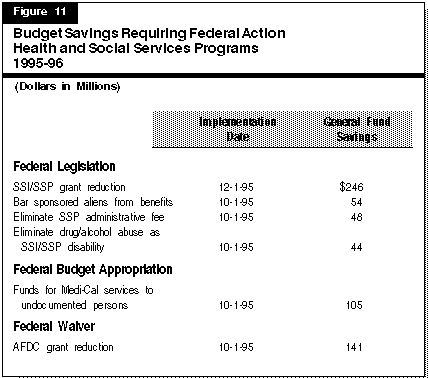
JUDICIARY AND CRIMINAL JUSTICE
In this section, we describe the major features of the budget package as they relate to judiciary and criminal justice programs (courts, adult and youth corrections, and other justice-related programs). The 1995-96 budget for these programs totals $4.7 billion, including $4.4 billion from the General Fund and $287 million from state special funds. This amount is about $723 million below the level proposed by the Governor in January. This reduction is primarily due to the Legislature's rejection of the state-county realignment proposal, thereby reducing General Fund support for the Trial Court Funding Program by $592 million below the proposed level.
As compared to 1994-95, the General Fund amount represents an increase of $296 million, or about 6.5 percent, above estimated spending for these programs. The budget assumes that the state will receive $413 million in federal funds to offset the costs of incarcerating and supervising undocumented felons in state prisons and the Youth Authority. If General Fund expenditures are adjusted to account for these federal funds (as the Governor did in his January budget), total General Fund expenditures would actually decrease by $84 million, or 1.8 percent, since 1994-95.
Figure 12 shows the major changes in the 1995 Budget Act relative to the Governor's Budget.
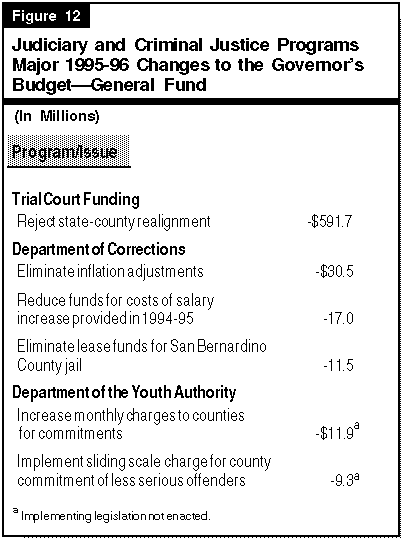
Judiciary
The 1995 Budget Act provides $165 million for support of the state judiciary, which includes the California Supreme Court, the Courts of Appeal, Judicial Council, and the Commission on Judicial Performance. This represents an increase of $14.2 million, or 9.4 percent, above 1994-95 expenditures. The increase is primarily due to caseload and rate increases for court-appointed counsel services and increased staffing to legislatively approved levels.
Trial Court Funding
In January, the Governor proposed about $1.3 billion for support of the Trial Court Funding Program, which was roughly a two-fold increase, as part of his state and county restructuring proposal. The Legislature ultimately rejected the proposal and deleted $592 million of the proposed increase. Thus, the budget provides a total of $663 million ($508 million from the General Fund and $155 million from penalty and fine revenues) for support of local trial courts in 1995-96. This level of state support covers about 37 percent of statewide trial court expenses in 1995-96, or about 1 percent more than the state's 36 percent share paid in 1994-95.
Department of Corrections
The budget provides a total of $3.3 billion ($3.2 billion from the General Fund and $59 million from special and bond funds) for support of the California Department of Corrections (CDC). This represents an increase of about 8 percent above the 1994-95 level and is primarily due to projected increases in inmate and parole populations. The most significant reductions below the level initially requested by the Governor in January were elimination of funds proposed to lease a jail in San Bernardino County in order to house state prison inmates ($11.5 million), elimination of funds for inflation adjustments ($30.5 million), and reduction in funds for the annualized costs of employee pay increases granted in 1994-95 ($17 million). Instead of receiving additional funds to cover these costs, the department will have to absorb these last two reductions within its existing budget. The budget also includes a net reduction of about $38.1 million below the January request to reflect changes in caseload estimates contained in the May Revision.
Inmate and Parole Caseloads. The Legislature considered a number of changes that would have saved money by reducing the number or length of stay of offenders in prison and on parole. None of these changes were included in the final budget, however. The budget is based on the administration's projected inmate population of about 142,500 inmates by June 30, 1996, an increase of approximately 11 percent over 1994-95. The parole population is projected to reach about 94,000 parolees by June 30, 1996, an increase of about 1 percent.
New Prisons. The budget includes $27 million to activate new prisons in Lassen and Monterey Counties and to fully open a new prison in Madera County that was activated in 1994-95. These facilities are designed to house a total of about 5,500 inmates. The budget also includes $126 million ($116 million in bond funds and $10 million in the General Fund) for construction of 16,500 emergency beds in 22 existing institutions.
Federal Funds for Incarceration and Supervision of Undocumented Felons. The budget assumes receipt of $413 million in federal funds to offset the state's costs for the incarceration of undocumented inmates and wards in state prison and the Youth Authority, as well as the supervision of undocumented immigrant parolees. This amount represents an increase of $380 million over the amount the state received in 1994-95 and is about $168 million higher than existing federal authorizations and appropriations for this purpose.
Department of the Youth Authority
The budget provides $345 million ($343 million from the General Fund and $1.5 million from special and bond funds) for support of the Department of the Youth Authority. The General Fund amount is $13.4 million, or 3.7 percent, less than 1994-95 expenditures. The budget includes an augmentation of $9.7 million from the General Fund (including $3.3 million in Proposition 98 funds) to cover the costs of the projected increase of 5.5 percent in the Youth Authority's ward population and 4.8 percent in the parole population. These increases were offset by elimination of one-time expenditures in 1994-95 and reductions that were to be offset by increases in fees charged to counties for commitments to the Youth Authority.
Increases in County Fees for Youth Authority Commitments.The budget assumed enactment of a trailer bill, AB 906 (Aguiar), with two provisions that would increase the fees paid by counties, thereby partially offsetting the state's costs of commitments to the Youth Authority. The department's General Fund budget was reduced by $21.3 million in anticipation of passage of AB 906.
The first provision would increase from $25 to $150 the monthly charges paid by counties for Youth Authority commitments, based on changes in inflation since the fee was established in 1961. This change would result in a General Fund savings of $11.9 million. The second provision would institute a "sliding scale" whereby counties would pay additional fees to cover the costs of less serious offenders who are committed to the Youth Authority. This change would result in a General Fund savings of $9.3 million.
Assembly Bill 906 was not enacted, however, and, no other legislation was enacted that contained the fee increases. Consequently, the department will have to absorb this as an unallocated reduction or propose a deficiency. The budget totals prepared by the Department of Finance assume that these savings will not be realized and the Youth Authority will receive a deficiency allocation of $21.3 million.
State Support of County Probation Camps and Ranches Not Enacted. Assembly Bill 906 also included an appropriation of $32.7 million to the Youth Authority for distribution to approximately 21 counties to support county probation camps and ranches that house juvenile offenders. As we indicated above, AB 906 was not enacted, nor was any other bill that contained the funds for the county camps and ranches.
Transportation
Support. The 1995-96 budget provides about $1.6 billion from various special funds for support of the Department of Transportation (Caltrans)--about 5 percent less than in 1994-95. The reduction is the net result of several large budget adjustments, including:
- The budget reduces (1) support in various programs throughout Caltrans by $67 million and (2) capital outlay support by $71 million. These reductions result in a decline in Caltrans staff of 1,129 personnel-years.
- The budget also imposes a $28 million reduction that Caltrans will have to absorb within its existing budget to fund the full-year costs of salary increases granted in 1994-95. The budget also reduces $30 million from various programs including administration, vehicle purchase, and local planning of transportation projects.
- The budget includes $18 million for Caltrans to comply with a court order that it reduce toxic contamination of wastewater runoff from roads and from Caltrans' facilities.
Local Assistance. The budget provides $845 million for local assistance programs--about 8 percent less than in 1994-95. The reduction results mainly from appropriating $100 million, rather than the statutory level of $200 million, for the State-Local Transportation Partnership Program. This program provides state matching funds for local transportation projects.
Capital Outlay. The budget provides $2.4 billion for transportation capital outlay projects--about 33 percent more than in 1994-95. The increase is made possible by appropriating in 1995-96 federal and state transportation funds that are expected to be received in future years. Specifically, the budget assumes that in 1995-96 Caltrans will obligate $1.7 billion of future federal transportation funds and will also borrow up to $147 million against future state gas tax revenues. The budget also provides funds for seismic retrofit including $81 million for state highway bridges and $56 million for toll bridge seismic retrofit through March 1996. In addition, the Legislature has authorized a $2 billion general obligation bond that, subject to voter approval, would provide a new funding source for seismic retrofit of state highway bridges and toll bridges.
Transfers to the General Fund. The budget shifts $77 million from the State Highway Account to the General Fund in order to pay for debt service on state rail bonds in 1995-96. The budget also includes a $54 million transfer of revenues from document sales from the Motor Vehicle Account to the General Fund. In 1994-95, the budget made similar types of funding shifts.
Natural Resources
The budget provides a total of about $1.0 billion (about $430 million General Fund) for natural resources programs in 1995-96. This amount includes about $834 million to support various resources agencies and conservancies, and $162 million for local assistance and capital outlay. This amount is about $155 million (13 percent) less than estimated 1994-95 expenditures.
In particular, the 1995 budget provides $4.5 million from the Harbors and Watercraft Revolving Fund over three years to Los Angeles County for operational costs, contingent on the county accepting fee title for eight beaches from the state. If the county does not accept fee title for these beaches, then the Department of Parks and Recreation will continue to operate the beaches, at a cost in 1995-96 of about $6.8 million from the General Fund.
The 1995 budget also includes:
- $19.4 million from the California Beverage Container Recycling Fund for support of the Department of Parks and Recreation. This is a new funding source for the department and offsets General Fund costs.
- $20 million for the Department of Forestry and Fire Protection for emergency fire fighting operations.
Environmental Protection
The 1995 budget provides about $631 million for environmental protection programs, including about $561 million to support various environmental protection agencies, and $70 million for local assistance. This amount is about $5 million (1 percent) less than estimated 1994-95 expenditures--reflecting the following major changes:
- A $10 million increase in the Underground Storage Tank Cleanup Fund Program which is supported by assessments on tank owners.
- A reduction of $12.3 million in grants and loans for local water reclamation and wastewater treatment facility construction, mainly due to a depletion in bond funds to provide a state match for federal funds.
- A reduction of $7.3 million in support for various programs in the Department of Toxic Substances Control, in part to provide $4.1 million for an expedited hazardous waste site cleanup pilot program.
Capital Outlay
As shown in Figure 13, the 1995 Budget Act includes almost $700 million for capital outlay (excluding transportation and the State Water Project). This amount is $187 million less than proposed by the Governor. Major legislative changes to the Governor's Budget proposal included the following:
- A reduction of $137 million in general obligation bond funds for seismic retrofit of state buildings. In general, this reduction represents a deferral of funding for the construction phase of these projects because construction was not scheduled to begin in 1995-96.
- Reductions totaling $58 million (General Fund and lease-payment bonds) in projects for the Department of Corrections. This amount includes $42 million in reductions for the emergency housing program and $16 million from deferring the construction phase of two infrastructure projects.
- Deletion of $27�million from lease-payment bonds that was proposed for development of a new headquarters building for the Office of Emergency Services.
- An increase of $33�million from lease-payment bonds
for two community college construction projects.
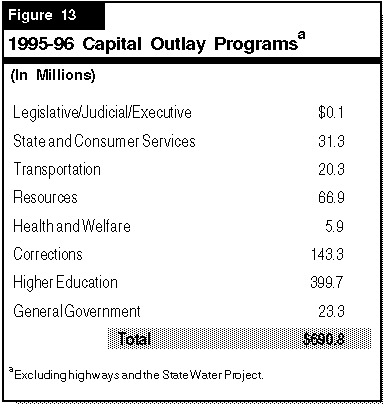
Bond Debt Service
Current Debt Service Costs. We estimate that the state�s General Fund debt service payments on long-term bonds (general obligation
and lease-payment) will be about $2.3�billion during 1995-96. This is about 5.3�percent of estimated General Fund revenues.
Future Debt Service Costs for Bond Appropriations in the 1995-96 Budget Act. The budget includes appropriations totaling about
$640�million from bond funds. This amount consists of $140�million from general obligation bonds and $500�million from lease-pay-ment
bonds. These bonds will be used for the following purposes:
- Capital outlay projects of state agencies and thecommunity colleges ($570�million).
- Capital planning and bond program administrativecosts of certain state agencies ($33�million).
-
Local government capital projects ($35�million).
The state�s General Fund debt service costs for these bonds would begin after 1995-96 and would average about $50�million annually
for about 25 years until the bonds are paid off.
Transportation Seismic Retrofit Program. The Legislature approved
one bond measure for the March 1996 ballot. As discussed under the
Transportation section, the 1995 budget package includes a $2�billion
general obligation bond measure, Ch 310/95 (SB 146, Maddy),
to finance earthquake safety improvements to the state�s transportation
system. If approved by the voters, the state�s General Fund
debt service costs for these bonds would begin after 1995-96 and
would average around $140�million for about 25 years until the
bonds are paid off.
General Government
Business and Labor Employee Compensation
Under approved memoranda of understanding (MOUs), represented
state employees (other than employees of the University of
California and the California State University) received a 3�percent
general salary increase (GSI) on January 1, 1995. The Department of
Personnel Administration approved an identical increase for
nonrepresented employees. The full-year, 1995-96 costs due to this
GSI, however, are provided only for that portion attributable to
employees directly engaged in public safety, 24-hour care, or revenue-
generating activities within 15 specified departments. The
amounts needed to pay the GSI to other state employees will be
borne by departments and agencies from existing support funds.
Negotiations are underway for new MOUs, but have been completed
only for bargaining unit 5 (highway patrol officers). The
budget does not include funds for new employee compensation
costs that may be included in these prospective MOUs. Any MOUs
requiring the expenditure of state funds would be subject to approval
by the Legislature through the enactment of legislation.
When this report was written, SB�544 (Dills) contained approval of
the proposed unit 5 MOU and appropriated $17.1�million from the
Motor Vehicle Account and other special funds for additional salary
and benefit costs of the MOU in 1995-96. According to the Department
of Personnel Administration, these costs will total about
$30�million in 1996-97.
Unallocated Reductions
The 1995 Budget Act includes two control sections requiring the
Department of Finance to reduce General Fund appropriations by
a statewide total of $45�million. Section 3.75 mandates $10�million of
savings resulting from reductions in managers, supervisors, or
administrative costs. Section 3.90 imposes an unallocated reduction
of $35�million to state operations. The Legislature exempted various
departments and other entities from the provisions of one or both of
the control sections.
Department of Insurance
The Legislature approved a $9.4�million augmentation from the
Insurance Fund for the Department of Insurance to conduct Propo-sition
103 rate rollback hearings. The department expects many
insurance companies to request evidentiary hearings before they
will meet their rate rollback obligation. This augmentation will be
financed by a 47�percent increase in the fee the department charges
to administer Proposition 103.
REVENUES
Budget Actions to Increase Collections
The 1995-96 budget package includes the following actions to
enhance revenue collections:
Collections from Federal Tax Refunds. The budget assumes that the
federal government will enact legislation to collect delinquent state
taxes out of refunds owed to federal taxpayers (the state currently
provides a similar service for the federal government). Congress is
currently considering this legislation, which the budget estimates
would generate state revenues of $85 million in 1995-96.
Enhanced Audit and Collection Activities. The Legislature added a
total of $7 million to the budgets of the Franchise Tax Board and the
State Board of Equalization to fund additional personnel to enhance
audit and collection activities. These audit and collection activities
will increase tax revenues by an estimated $61 million in 1995-96.
Governor�s Proposed Tax Reductions
Not Included in the 1995-96 Budget
The budget package does not include the tax reductions proposed
by the Governor in January and May. Instead, these proposals are
being considered in legislation separate from the budget package.
Phased-In Income Tax Reduction Proposal. Under this proposal,
the current temporary 10 percent and 11 percent income tax rates for
high-income taxpayers, scheduled to sunset in 1996, would have remained in effect. However, those rates and most other business
and personal income tax rates then would have been reduced by
5 percent increments each year over a three-year period beginning
in 1996. The Franchise Tax Board estimated that this proposal would
have resulted in a net revenue reduction of $179 million in 1995-96
and a cumulative net revenue reduction for the first four fiscal years
of $7.1 billion.
The revenue estimate for the 1995-96 budget package includes the
effect of the sunset of the higher income tax rates in 1996 (a loss of
$325 million in 1995-96).
Other Proposals. The adopted budget also does not include two
other tax changes proposed by the Governor in the May Revision.
One change would have liberalized the tax credit for hiring employees
in enterprise zones ($10 million 1995-96 revenue loss). The
second change would have conformed state tax law with federal tax
law regarding cancellation of debts and the treatment of credits and
deductions related to passive business income ($34 million 1995-96
revenue loss).
Return to Table of Contents
Return to LAO Home Page

